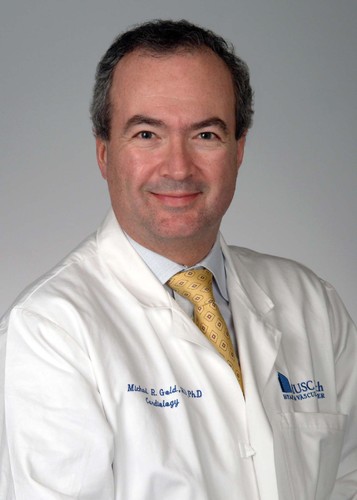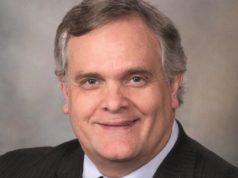
Findings from the UNTOUCHED study, presented online in a late-breaking trial session at HRS 2020 Science, showed that patients receiving subcutaneous implantable cardioverter defibrillator (S-ICD) therapy experienced a higher inappropriate shock-free rate than in previous S-ICD and transvenous implantable cardioverter-defibrillator (TV-ICD) studies.
This was according to the study’s principal investigator Michael R Gold, MD, PhD (Division of Cardiology, Medical University of South Carolina, Charleston, USA), who presented the findings at HRS 2020 Science. The study evaluated the safety and efficacy of the EMBLEM S-ICD System (Boston Scientific), for primary prevention of sudden cardiac death specifically in patients with a left ventricular ejection fraction (LVEF) ≤35%
Gold explained that S-ICDs were designed to provide protection from sudden cardiac death while avoiding complications associated with transvenous lead systems. However, he noted, relatively high inappropriate shock rates have been reported with first generation devices and implant techniques. No prospective study has evaluated outcomes with the S-ICD using modern devices and programming settings in a traditional primary prevention population, he said.
Gold and colleagues hypothesised that the incidence of inappropriate shocks in primary prevention, LVEF ≤35% patients would be non-inferior to the rate in transvenous ICD patients with similar programming observed in the MADIT-RIT clinical trial, arms B and C.
UNTOUCHED was a global, multicentre, prospective non-randomised study, which enrolled de novo implanted patients at 110 sites in the US and Europe, who were followed for 18 months. Devices were prescriptively programmed, with a conditional zone set to 200bpm and an aggressive shock zone of 250 bpm, Gold explained. Patients were enrolled if they had a primary indication for sudden cardiac death, LVEF ≤35%, without pacing indication, and if they passed the S-ICD screening test.
The study’s primary endpoint was an inappropriate shock-free rate at 18 months, compared to a performance goal of a lower 95% confidence interval of 91.6%, which was derived from the inappropriate shock rate of 94.6% measured in ICD patients in the comparator study, MADIT-RIT study arms B and C when CRT was excluded. Secondary endpoints included the all cause shock free rate at 18 months, with a performance goal of 85.8%, and system and procedure-related complication procedure complication rate at 30 days.
Implants were attempted in 1,116 patients, Gold explained, with endpoint analysis reported in 1,111 patients who received devices. Patients had an average age of 56, 25.7% (n=286) were female and 87.6% (n=883) had heart failure. “Compared to other S-ICD studies,” remarked Gold, “the UNTOUCHED patient population is sicker, with lower ejection fractions, more heart failure diagnoses and a higher rate of ischemic aetiology. However, the patient cohort is similar to that in landmark transvenous ICD studies, such as MADIT II, SCD-HeFT and MADIT RIT, except that they were a younger population, presumably due to the pacing indication exclusion criterion.”
Primary endpoint results presented by Gold demonstrated an inappropriate shock-free rate of 95.9%, exceeding the performance goal of 91.6%. Patients with a history of atrial fibrillation, non-ischemic aetiology, and lower ejection fraction, were more likely to experience inappropriate shocks, Gold commented. Procedural characteristics that predicted fewer shocks for the patients, he explained, were implantation using the three incision technique, and implanting devices with a SMART Pass filter. Gold said that when comparing the shock rates from recent S-ICD studies, there has been a decrease in the number of inappropriate shocks recorded over time. “The one-year inappropriate shock rate for UNTOUCHED is the lowest recorded to date for large multicentre trials,” Gold said.
The secondary endpoint, the all-cause shock-free rate stood at 90.6%, meeting its performance goal of 85.8%. Significant multivariable predictors of all-cause shocks include a history of atrial fibrillation and lower ejection fraction, Gold added.

Discussing the results further, Gold explained that the UNTOUCHED patient cohort experienced a total of 64 appropriate shocks in discrete episodes. The first shock success rate stood at 92.2%, Gold noted, and the final shock success rate was measured at 98.4%. The one episode with a failed final shock converted spontaneously, Gold noted, adding that these were similar rates of success compared with transvenous studies. Seven subject collectively experienced 58 episodes in nine VT storm events, all of which were successfully converted. The overall survival rate of this cohort was 94.9% at 18 months, according to Gold. Of the 53 deaths recorded during the 18-month follow-up, 26 were recorded to be of cardiac origin, including three arrhythmic deaths.
In conclusion, Gold commented that the UNTOUCHED study shows high S-ICD efficacy and safety with contemporary devices and programming, “despite the sickest cohort to date”. “The inappropriate shock rate—which is 3.1% at one year—is the lowest reported for the S-ICD, and lower than many transvenous device studies using contemporary programming to reduce inappropriate shocks.”
Providing a commentary on the results following Gold’s presentation, Dave Callans (Perelman School of Medicine, University of Pennsylvania, Philadelphia, USA) remarked: “I think the UNTOUCHED registry was a very important trial, it successfully demonstrated in a large population of patients a remarkable reduction in inappropriate shock incidence with improvement in technology and programming.”
Usha B Tendrow (Brigham and Women’s Hospital, Boston, USA) commented on differences between the UNTOUCHED trial and the comparator study, MADRIT RIT arms B and C. She said: “[It is] Important for us to think about how the MADIT RIT population might differ from the cohort in UNTOUCHED. The S-ICD patients in UNTOUCHED had no pacing indication, and had to pass the ECG vector screening. In MADIT RIT arms B and C, around half of the population received a CRT-D, perhaps indicating a sicker cohort.”
A randomised trial would be ideal for comparing transvenous and S-ICD shock rates to establish non-inferiority, Tendrow commented, adding: “UNTOUCHED additionally provides some important corroborating evidence that adding specialised high pass filtering can further improve the inappropriate shock rate for the S-ICD.”












